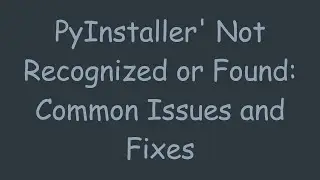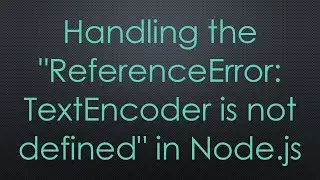Mastering URL Redirection with .htaccess
Learn how to effectively redirect multiple URLs using your `.htaccess` file with practical examples and easy-to-follow guidelines.
---
This video is based on the question https://stackoverflow.com/q/68511575/ asked by the user 'ZiTix' ( https://stackoverflow.com/u/16517644/ ) and on the answer https://stackoverflow.com/a/68511721/ provided by the user 'RavinderSingh13' ( https://stackoverflow.com/u/5866580/ ) at 'Stack Overflow' website. Thanks to these great users and Stackexchange community for their contributions.
Visit these links for original content and any more details, such as alternate solutions, latest updates/developments on topic, comments, revision history etc. For example, the original title of the Question was: How i can redirect several url with htaccess file?
Also, Content (except music) licensed under CC BY-SA https://meta.stackexchange.com/help/l...
The original Question post is licensed under the 'CC BY-SA 4.0' ( https://creativecommons.org/licenses/... ) license, and the original Answer post is licensed under the 'CC BY-SA 4.0' ( https://creativecommons.org/licenses/... ) license.
If anything seems off to you, please feel free to write me at vlogize [AT] gmail [DOT] com.
---
Mastering URL Redirection with .htaccess: A Comprehensive Guide
When developing or managing a website, configuring your URL redirection can often pose challenges. A common issue arises when you want to redirect specific URL paths to different scripts or pages while making sure multiple rules do not conflict. If you're struggling with this, you're not alone. This guide dives into how to redirect multiple URLs using your .htaccess file, making things simpler for the navigation of your site.
Understanding the Basics of .htaccess
The .htaccess file is a powerful configuration file found in Apache servers that allows you to control various server settings. One of its most popular uses is for URL rewriting and redirection. Using the RewriteRule directive, you can manage how URLs are processed based on specific patterns.
The Problem: Conflicting Redirects
In your case, you attempted to redirect two specific paths:
dashboard/{Server ID} to guild.php
dashboard/{Server ID}/features to features.php
However, since the first rule was written in a way that it captured both URLs, it was redirecting everything to guild.php, ignoring the more specific features.php rule.
The Solution: Updated Rewrite Rules
To resolve this issue, you will need to edit your .htaccess file with refined rules for your redirections. Here's how to do it effectively:
Step 1: Enable Rewrite Engine
Before you can start using redirection rules, you need to ensure that the rewrite engine is turned on.
[[See Video to Reveal this Text or Code Snippet]]
Step 2: Specific Rules for Each URL
Now, let's outline the specific rules you're going to implement. Here’s how you can structure them in your .htaccess file:
[[See Video to Reveal this Text or Code Snippet]]
Breakdown of the Rewrite Rules
Pattern Matching: ^dashboard/([^/]*)/features/?$ targets URLs ending with /features, capturing the server ID into a back-reference $1 which is then passed to features.php.
NC and L Flags:
NC (No Case) makes the rule case insensitive, so it will work regardless of how the user types it.
L (Last) indicates that if this rule matches, no further rules will be processed.
Step 3: Clear Your Cache
After updating your .htaccess file, make sure to clear your browser cache before testing the URLs. This avoids seeing stale results due to caching.
Conclusion
With these updated rules, you should be able to successfully redirect the specified URLs without conflict. The first rule will now capture requests for the features page, directing it to features.php, while the second will handle the basic dashboard/{Server ID} requests efficiently. Understanding how to manage .htaccess rules helps create clean, user-friendly URLs, which is an essential skill for any web developer.
If you encounter further issues or have specific configurations you’d like assistance with, feel free to reach out! Happy coding!































